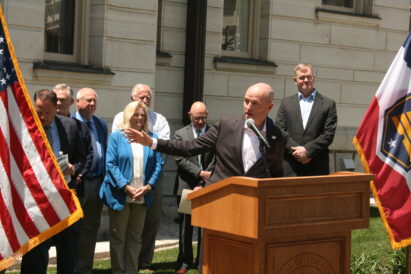Ogden officials say city is backing off green lawn ordinance
OGDEN — With water at a premium and temperatures continuing to soar, Ogden City officials say they’re backing off enforcement of an ordinance that requires residents to keep their lawns green.
Environmental factors like an abnormally sparse snowpack, a dry spring and summer and July temperatures consistently in the upper 90s have converged to prompt some government entities, and people in general, to be extra mindful about conserving water this year.
RELATED: 2018 snowpack might be Utah’s worst on record, according to Utah Snow Survey
The situation is severe in some areas. The Benchland Water District in Farmington for example, has initiated a firm set of secondary watering restrictions. Residents serviced by the district have been prohibited from watering on weekends, any time between 10 a.m. and 6 p.m. and on any new landscaping.
Officials have been earnest in issuing citations to residents who don’t follow the directive, said Farmington City Manager Dave Millheim.
“It’s more important to be able to take a shower and flush your toilet than it is to water your lawn,” Millheim said.
In Ogden, the city has long had an ordinance governing the condition of residents’ lawns.
It’s first important to note though, that the city doesn’t technically require homeowners to even have a lawn.
RELATED: Ogden proposal will require secondary water for irrigation where it’s possible
Landscaping rocks, gravel, mulches, artificial turf or wood chips can be used as ground cover without city approval as long as those materials don’t cover more than 10 percent of the ground area.
Residents can exceed the 10 percent threshold, said Ogden Assistant City Attorney Mark Stratford in an email, so long as the design is approved by the city planning staff. The planning staff uses a large set of criteria when making determinations.
Story continues below photo.

MATT HERP/Standard-Examiner
Sprinklers water the front lawn of Larry and Kathie Hamburg’s home Thursday, July 26, 2018, in the 2300 block of Fowler Avenue in Ogden.
Once a resident commits to grass and seeds sprout in their yard, though, the city has some say in how the final product looks.
“Whatever is planted is expected to be taken care of,” Stratford said.
The city’s code on landscaping (section 15-13-16) says “all plantings shall be maintained in a healthy and attractive condition (and)… shall be adequately watered to maintain a healthy condition as by the typical color of the plant under normal growing conditions.”
RELATED: Ogden man sings the virtues of artificial grass in turf war
Ogden Chief Administrative Officer Mark Johnson said the city has been using a liberal interpretation of the code this year.
“We’re recognizing — because of the kind of year we’ve had — that it’s impossible to keep your lawn green in many cases,” Johnson said. “But we still expect some basic care and residents shouldn’t just let their lawns start dying out.”
One key factor complicates the watering issue in Ogden. According to city council documents, just under 50 percent of city residents have access to secondary water, meaning many are required to use culinary water for their outdoor watering needs.
Secondary water rates throughout the city vary depending on the provider, but even with those variations, it’s generally much less expensive to irrigate your yard with secondary water than it is with culinary water.
Kris Olsen lives in the east-central area of Ogden, in a home that does not have secondary water.
In June, Olsen received a notice from the city about the condition of her lawn and some other curbside appearance items. Though she was not cited, Olsen said she was warned that she would be if she didn’t improve the condition of her property, including the lawn.
She says she’d been about 15 years without watering because with only culinary water access, her bill just got to be too expensive. Olsen covered her yard with some colored mulch and hasn’t heard anything more from the city. She still doesn’t like the ordinance though.
“Like I said, I haven’t been fined or anything, so I can appreciate that, but (the ordinance) just seems wrong,” she said. “First, I think it’s unfair to the lower income population because we’re the ones without secondary water. Then you factor in how dry it’s getting, it just doesn’t make a whole lot of sense.”
You can reach reporter Mitch Shaw at mishaw@standard.net. Follow him on Twitter at @mitchshaw23 or like him on Facebook at Facebook.com/MitchShaw.StandardExaminer.




















